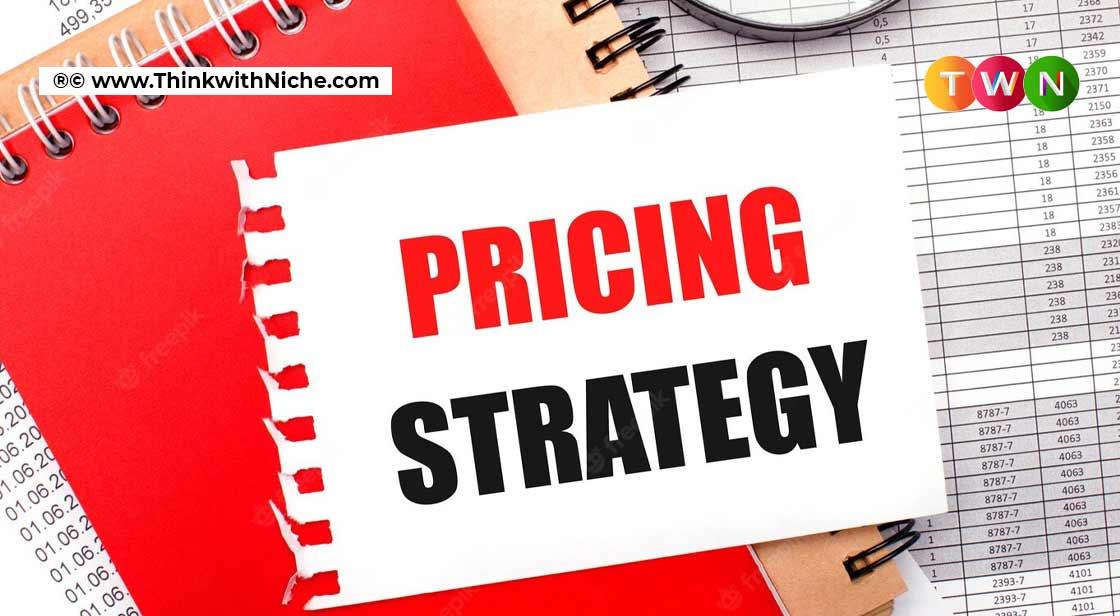14 Smart Pricing Strategies to Attract Customers

Blog Post
The price you set for your product or service, regardless of what you're selling, can make or break your company's financial goals. Of course, finding the right price will not happen overnight. When you want your customers to buy without sacrificing a large profit margin, you must have a well-thought-out pricing strategy.
There is no one-size-fits-all answer to how much your markup should be. Some businesses make millions by charging only a few dollars, while others may succeed by charging exorbitant prices. Finally, consumers will only choose products or services whose prices correspond to their perceived value.
So, how do you determine the true worth of what you're selling, aside from the cost of production? You'll be able to account for all of the factors that influence a shopper's willingness to buy with the right pricing strategy. That's why I have compiled a list of 14 Pricing Strategies that will help you attract more customers. #TWN
Pricing your products or services can be tricky.
If you set your prices too high, you will lose valuable sales. If you set them too low, you will lose out on valuable revenue. Pricing, thankfully, does not have to be a sacrifice or a wild guess. There are a plethora of pricing models and strategies that can assist you in better understanding how to set the right prices for your audience and revenue goals.
That is why we have put together this guide.
Whether you're a newcomer to business or a seasoned pricing expert, the tactics and strategies in this guide will help you get comfortable pricing your products. Save this guide for later and use the chapter links to navigate to specific sections of interest.
Pricing Strategy Explained!
A pricing strategy is a model or method for determining the most competitive price for a product or service. It assists you in specifying prices that maximize profits and shareholder value while taking consumer and market demand into account.
If only pricing were as simple as its definition — there's a lot that goes into it.
Many aspects of your business, such as revenue goals, marketing objectives, target audience, brand positioning, and product attributes, are factored into pricing strategies. External factors such as consumer demand, competitor pricing, and overall market and economic trends all have an impact on them.
It's not uncommon for entrepreneurs and business owners to overprice their products and services. They frequently consider the cost of goods sold (COGS) and competitor rates and adjust their selling price by a few dollars. While your costs of goods sold and competitors are important, they should not be the focus of your pricing strategy.
Your profit and revenue will be maximized if you use the best pricing strategy.
Types of Pricing Strategies to Attract Customers
- Competition-Based Pricing
- Cost-Plus Pricing
- Dynamic Pricing
- Freemium Pricing
- High-Low Pricing
- Hourly Pricing
- Skimming Pricing
- Penetration Pricing
- Premium Pricing
- Project-Based Pricing
- Value-Based Pricing
- Bundle Pricing
- Psychological Pricing
- Geographic Pricing
Now let's look at the descriptions of each pricing strategy — many of which are included in the template below — to see what makes them different.
14. Geographic Pricing Strategy
Geographic pricing refers to the practice of pricing products or services differently based on their geographical location or market.
This strategy may be used if a customer from another country makes a purchase or if there are disparities in factors such as the economy or wages (from the location where you're selling a good to the location of the person to whom it is sold).
Geographic Pricing Strategy in Marketing
Paid social media advertising makes it simple to market a geographically priced product or service. Segmenting by zip code, city, or even region can be done at a low cost and with high accuracy. Even if specific customers travel or relocate permanently, your pricing model will remain consistent, allowing you to keep your marketing costs low.
13. Psychological Pricing Strategy
Psychological pricing is exactly what it sounds like: it uses human psychology to increase sales.
According to the "9-digit effect," even though a product costing $99.99 is ideally $100, customers may perceive it as a good deal simply because of the "9" in the price.
Another way to use psychological pricing is to place a more expensive item directly next to the one you're most interested in selling (either in-store or online). Alternatively, offer a "buy one, get one half off (or free)" deal that makes customers feel as if the circumstances are too good to pass up.
Finally, in some cases, changing the font, size, and color of your pricing information on and around your products has been shown to increase sales.
Psychological Pricing Strategy in Marketing
To produce the best results, psychological pricing strategy necessitates a thorough understanding of your target market. If your customers are interested in discounts and coupons, appealing to this desire through marketing can assist this product in meeting their psychological need to save money. If your audience values quality, having the lowest price on the shelf may not help you meet your sales targets. Whatever the reasons your customers have for paying a particular price for a product, your pricing and marketing should appeal to those reasons.
12. Bundle Pricing Strategy
When you offer (or "bundle") two or more complementary products or services together and sell them for a single price, you are using a bundle pricing strategy. You have the option of selling your bundled products or services only as part of a bundle or as both bundle components and individual products.
It is a great way to add value to your offerings for customers who are willing to pay more upfront for multiple products. It can also help you get your customers addicted to more than one of your products more quickly.
Bundle Pricing Strategy in Marketing
Marketing bundle deals can help you sell more products than you would if you sold them separately. It's a clever way to upsell and cross-sell your offerings in a way that benefits both the customer and your revenue targets.
11. Value-Based Pricing Strategy
When companies use a value-based pricing strategy, they price their products or services based on what the customer is willing to pay. Even if it can charge a higher price for a product, the company decides to set its prices based on customer interest and data.
Value-based pricing, when used correctly, can increase customer sentiment and loyalty. It can also assist you in prioritizing your customers in other areas of your business, such as marketing and customer service.
On the other hand, value-based pricing necessitates that you stay in touch with your various customer profiles and buyer personas and possibly adjust your prices based on those differences.
Value-Based Pricing Strategy in Marketing
Because marketing to customers should always begin with value, having a value-based pricing model should help strengthen demand for your products and services. Just make sure your target audiences are clear about what they're willing to pay for — you don't want to get into trouble by charging more or less based on arbitrary criteria.
10. Project-Based Pricing Strategy
A project-based pricing strategy is diametrically opposed to hourly pricing in that it charges a flat fee per project rather than a direct exchange of money for time. Consultants, freelancers, contractors, and other individuals or laborers who provide business services use it as well.
The value of the project deliverables can be used to estimate project-based pricing. Those who choose this pricing strategy may also create a flat fee based on the project's estimated time.
Project-Based Pricing Strategy in Marketing
Leading with the advantages that a customer will gain from working with your company on a project can make project-based pricing more appealing. Although the project's costs may be high, the one-time investment may be worthwhile. Your clients will understand that they will be able to work with you until the project is finished rather than until their allotted hours are exhausted.
9. Premium Pricing Strategy
A premium pricing strategy, also known as prestige pricing and luxury pricing, is when companies charge a high price for their products to project the image that they are high-value, luxury, or premium. Prestige pricing is based on a product's perceived value rather than its actual value or production cost.
Prestige pricing is directly proportional to brand awareness and perception. This pricing method is used by brands that are known for providing value and status through their products, which is why they are priced higher than competitors. Because they can be marketed as luxurious, exclusive, and rare, fashion and technology are frequently priced using this strategy.
Premium Pricing Strategy in Marketing
Premium pricing is majorly dependent on the market perception of your product. Using influencers, controlling supply, and driving up demand are ways to market your product to influence a premium perception of it.
8. Penetration Pricing Strategy
A penetration pricing strategy, as opposed to skimming pricing, is when a company enters the market with an extremely low price, effectively drawing attention (and revenue) away from higher-priced competitors. Penetration pricing, on the other hand, is not long-term sustainable and is typically used for a limited time.
This pricing method is best suited for brand new businesses seeking customers or for businesses entering an existing, competitive market. The strategy revolves entirely around disruption and temporary loss... and hoping that your initial customers will stick with you as you gradually raise your prices.
(Another tangential strategy is loss-leader pricing, in which retailers attract customers with purposefully low-priced items in the hopes that they will also purchase other, higher-priced products.) It is how retailers like Target get you — and me.)
Penetration Pricing Strategy in Marketing
Penetration pricing has the same implications as freemium pricing in that the money will not appear overnight. However, if you provide enough value and have a great product or service, you may be able to continue to make money and scale your business as you raise your prices. One tip for this pricing strategy is to market the value of the products you sell rather than the price.
7. Skimming Pricing Strategy
Skimming pricing occurs when a company charges the highest possible price for a new product and then gradually lowers the price as the product becomes less and less popular. Skimming differs from high-low pricing in that prices are gradually reduced over time.
As technology products become less relevant over time, such as DVD players, video game consoles, and smartphones, they are typically priced using this strategy. A skimming pricing strategy can help recover sunk costs and sell products well beyond their novelty, but it can also irritate customers who paid full price and attract competitors who recognize the "fake" pricing margin as prices are lowered.
Skimming Pricing Strategy in Marketing
If you sell products with varying life cycle lengths, a skimming pricing strategy can be effective. Because one product's popularity can fluctuate quickly, you only have a limited time to profit from it in the early stages of its life cycle. A product with a longer life cycle, on the other hand, can maintain a higher price for a longer period. You'll be able to maintain your marketing efforts for each product more effectively without having to constantly adjust your pricing across all of your products.
6. Hourly Pricing Strategy
Consultants, freelancers, contractors, and other individuals or laborers who provide business services frequently use hourly pricing, also known as rate-based pricing. Hourly pricing is essentially a time-for-money exchange. Some clients are hesitant to honor this pricing strategy because it may favor labor over efficiency.
Hourly Pricing Strategy in Marketing
If your company thrives on quick, high-volume projects, hourly pricing may be just what you need to entice customers to work with you. Customers can choose to work with you based on a low price point rather than finding room in their budget for an expensive project-based commitment if you break down your prices into hourly chunks.
5. High-Low Pricing Strategy
A high-low pricing strategy is when a company sells a product at a high price at first but then lowers the price as the product loses novelty or relevance. Discounts, clearance sections, and year-end sales are examples of high-low pricing in action, which is why this strategy is sometimes referred to as a discount pricing strategy.
Retailers who sell seasonal items or products that change frequently, such as clothing, decor, and furniture, frequently use high-low pricing. What appeals to sellers about a high/low pricing strategy? Consumers enjoy looking forward to sales and discounts, which is why Black Friday and other universal discount days are so popular.
High-Low Pricing Strategy in Marketing
A high-low pricing strategy can help you maintain consistent foot traffic in your stores all year. By analyzing the popularity of your products at different times of the year, you can use low pricing to boost sales during traditionally slow months.
4. Freemium Pricing Strategy
Freemium pricing, a combination of the words "free" and "premium," is when companies offer a basic version of their product in the hopes that users will eventually pay to upgrade or access more features. Freemium, as opposed to cost-plus, is a pricing strategy commonly used by SaaS and other software companies. They choose this strategy because free trials and limited memberships provide a preview of a software's full functionality while also establishing trust with a potential customer before purchase.
In the case of freemium, a company's prices must be determined by the perceived value of its products. Companies that provide a free version of their software, for example, cannot charge users $100 to upgrade to the paid version. Prices must have a low entry barrier and gradually increase as customers are offered more features and benefits.
Freemium Pricing Strategy in Marketing
Freemium pricing may not save your company money on the initial acquisition of a customer, but it does provide you with access to the customer, which is just as valuable. You can nurture the customer into a brand loyal advocate with a worthwhile LTV if you have access to their email inboxes, phone numbers, and any other contact information you collect in exchange for the free product.
3. Dynamic Pricing Strategy
Surge pricing, demand pricing, and time-based pricing are all terms used to describe dynamic pricing. It is a pricing strategy that allows prices to fluctuate based on market and customer demand.
Dynamic pricing is used by hotels, airlines, event venues, and utility companies by employing algorithms that take into account competitor pricing, demand, and other factors. These algorithms enable businesses to adjust prices based on when and what the customer is willing to pay at the precise moment they are ready to make a purchase.
Dynamic Pricing Strategy in Marketing
Dynamic pricing can assist you in staying on track with your marketing plans. Your team can plan ahead of time for promotions and configure the pricing algorithm you use to launch the promotion price at the optimal time. To maximize your profits, you can even A/B test dynamic pricing in real-time.
2. Cost-Plus Pricing Strategy
A cost-plus pricing strategy is solely concerned with the cost of producing your product or service, also known as your COGS. It's also known as markup pricing because companies that use this strategy "markup" their products based on how much profit they want to make.
To use the cost-plus method, add a fixed percentage to the cost of your product's production. Assume you were a shoe salesperson. The shoes cost $25 to make, and you want a profit of $25 on each sale. You'd set a price of $50, representing a 100% markup.
In the case of freemium, a company's prices must be determined by the perceived value of its products. Companies that provide a free version of their software, for example, cannot charge users $100 to upgrade to the paid version. Prices must have a low entry barrier and gradually increase as customers are offered more features and benefits.
Cost-Plus Pricing Strategy in Marketing
When the competition uses the same pricing model, cost-plus pricing works well. It will not help you attract new customers if your competitors are focused on acquiring customers rather than increasing profits. Before implementing this strategy, conduct a pricing analysis that includes your closest competitors to ensure that it will help you meet your objectives.
1. Competition-Based Pricing Strategy
Pricing based on competition is also known as competitive pricing or competitor-based pricing. This pricing strategy focuses on the current market rate (or going rate) for a company's product or service; it does not consider the product's cost or consumer demand.
A competition-based pricing strategy, on the other hand, uses the prices of competitors as a benchmark. Businesses that compete in a highly competitive market may choose this strategy because a slight price difference may be the deciding factor for customers.
With competition-based pricing, you can price your products slightly lower, the same as your competitors, or slightly higher than your competitors. For example, if you sold marketing automation software and your competitors' prices ranged from $19.99 per month to $39.99 per month, you'd set your price somewhere in the middle.
Whatever price you choose, keeping your pricing dynamic and competitive is one way to stay ahead of the competition.
Competition-Based Pricing Strategy in Marketing
Consumers want the best value, which isn't always the same as the lowest price. Pricing your products and services competitively in the market can help your brand win a customer's business. Competitive pricing works especially well when your company provides something that the competition does not, such as excellent customer service, a generous return policy, or access to exclusive loyalty benefits.
As I previously stated, these strategies are not intended to be used in isolation. I encourage you to use a combination of these methods as needed.
Pricing Strategy Examples
Pricing models can be difficult to visualize. We've compiled a list of pricing strategy examples that have been applied to real-world situations or businesses.
1. Dynamic Pricing Strategy: Chicago Cubs
I live five blocks from Wrigley Field in Chicago, and my friends and I enjoy going to Cubs games. Finding tickets is always interesting, though, because prices have changed slightly since the last time we checked. Buying tickets six weeks in advance is always a different process than buying them six days in advance — and sox pricing at the gate is even more so.
It is an example of dynamic pricing, which refers to pricing that changes based on market and customer demand. Prices for Cubs games are always higher on holidays when more people visit the city and are more likely to attend a game.
(ANOTHER good example of dynamic pricing is INBOUND, where tickets become more expensive as the event approaches.)
2. Freemium Pricing Strategy: HubSpot
HubSpot is a good example of freemium pricing in action. There is a free CRM version for scaling businesses, as well as paid plans for businesses using the CRM platform that require a broader range of features.
Furthermore, HubSpot restricts access to specific features within those marketing tools. This pricing strategy allows customers to become acquainted with HubSpot and allows HubSpot to build trust with customers before asking them to pay for additional access.
3. Penetration Pricing Strategy: Netflix
Netflix is a textbook example of penetration pricing: it enters the market at a low price (does anyone remember when it was $7.99?) and gradually raises prices. I've received a few price increase notices in my inbox since joining a couple of years ago.
Despite the price increases, Netflix continues to retain and gain customers. Netflix may only raise their subscription fee by $1 or $2 each time, but they do so consistently. Who knows what the fees will be in 5 or 10 years?
4. Premium Pricing: AWAY
There are a plethora of premium pricing strategies to choose from... You name it: Rolex, Tesla, Nike. AWAY luggage was the first thing that came to mind.
Is it necessary for luggage to cost nearly $500? I'd say no, especially since I just bought a two-piece Samsonite set for one-third the price. Despite charging a high price for their luggage, AWAY has remained very successful. It is because when you purchase AWAY, you are purchasing an experience. The luggage's value matches the purchase price due to the distinctive branding and image that AWAY conveys to customers.
5. Competitive Pricing Strategy: Shopify
Shopify is an eCommerce platform that assists businesses in managing their online stores and selling their products. Shopify has a competitive pricing strategy and integrates with HubSpot.
There are several eCommerce software options on the market today — Shopify distinguishes itself through the features it offers users and the price it charges. Customers can choose from three thoughtfully priced versions of their product, each with numerous customizable and flexible features.
With these extensive options tailored to the needs of any eCommerce business, Shopify's cost is highly competitive and is frequently the same as or lower than the cost of other eCommerce platforms on the market today.
6. Project-Based Pricing Strategy: Courtney Samuel Events
Anyone who has planned a wedding understands how expensive it can be. I'm putting together my own, and I've discovered that bundled, project-based fees are the easiest to manage. My wedding coordinator, Courtney, for example, charges a single flat fee for her services. This pricing strategy emphasizes the value of the outcome (for example, a stress-free wedding day) rather than the value of the time spent on calls, projects, or meetings.
A project-based fee better captures the value of Courtney's work because she typically provides a variety of services — wedding planning, day-of coordination, physical meetings, etc. — in addition to spending time answering questions and providing thoughtful suggestions. Project-based pricing is also advantageous for clients and businesses who would prefer to pay a flat fee or monthly retainer rather than deal with tracked hours or weekly invoices.
7. Value-Based Pricing Strategy: INBOUND
While INBOUND does not allow its attendees to choose the final ticket price, it does offer a variety of tickets from which customers can choose. Customers can choose what experience they want to have based on how much they value the event by offering multiple ticket "levels."
INBOUND tickets, on the other hand, change over time, so this pricing strategy could also be considered dynamic (like the Cubs example above). As the date of the INBOUND event approaches, the cost of tickets tends to rise.
8. Bundle Pricing: State Farm
State Farm is well-known for its witty advertisements and home and auto insurance package deals. You can get a quote for either one or both, but getting a quote for both can save you money on your premiums.
State Farm benefits from bundle pricing by selling more policies, while consumers benefit by paying less than they would if they used two different insurance companies for home and auto coverage.
9. Geographic Pricing: Gasoline
Gasoline prices vary widely around the world, but even within the United States, prices can vary by several dollars depending on the state you live in. For the past ten years, gas prices in California have consistently hovered around $3 during the summer months. During the same period, however, gas prices in Indiana have been in the $2 range. Laws, environmental factors, and production costs all have an impact on the price of gasoline in California, resulting in geographic disparities in the cost of fuel.
Walmart Pricing Strategy
Walmart is the world's largest company in terms of revenue, with $572.8 billion in FY22. It is also the largest private employer, employing 2.3 million people and operating over 11,000 stores. Walmart now contributes about 2% of the US economy. Walmart's success can be attributed in large part to its Everyday Low Price (EDLP) strategy, which offers low prices to customers all year rather than just during sales events. This strategy boosts sales as well as customer loyalty.
Walmart incurs fewer advertising costs as a result of EDLP because they advertise on a more regular basis and thus pay less per advertisement. As prices change less frequently, consumer demand becomes more predictable, and predictable demand leads to fewer instances of overstocking and understocking. Many other companies use high-low pricing, a pricing strategy that involves offering goods at lower prices during sales events. More frequent shoppers who can take advantage of sales promotions may benefit from low-cost pricing. People in these market segments, on the other hand, shop less frequently and thus prefer a low price whenever they go to the store.
How Walmart Offers Low Prices
Walmart's low-price strategy has been in place since the company's inception. The philosophy of maintaining low prices was based on having a large scale and minimizing operating costs. The low-price model has gained traction over the years, allowing Walmart to offer even lower prices while incurring fewer costs.
Walmart has a presence in nearly every market segment and a large customer base. It certainly helps that a Walmart store is within 15 miles of 90% of the American population.
Their current levels of operational efficiency can be attributed to their cutting-edge supply chain and inventory levels. The supply chain management system is based on electronic product information, dealing directly with manufacturers, and having warehouses close to outlets. Walmart can use this strategy to determine what is required, how much is required, and when it is required. Walmart's warehouses are all located within 130 miles of its outlets, and the company owns a trucking fleet.
However, not all of Walmart's price-cutting strategies can be viewed positively. Employees at Walmart are paid pitiful wages and may be required to work overtime without pay. Underpaid workers have protested against Walmart as a result of this.
Since many businesses rely on Walmart for revenue, they have considerable bargaining power with them, allowing Walmart to press them to lower their prices.
B2B Pricing Strategies for eCommerce
1. Cost-plus pricing
2. Competitive pricing
3. Value-based pricing
4. Dynamic pricing
I have already covered these strategies above.
Get Your Pricing Strategy Right
It's easy to get lost in the details of pricing: competitors, production costs, customer demand, industry needs, profit margins... the list is endless. You don't have to master all of these factors at once, thankfully. Fortunately, you don't have to master all of these aspects at once.
Simply sit down, crunch some numbers (such as your COGS and profit targets), and determine what's most important for your company. Begin with what you require, and this will assist you in determining the best pricing strategy to employ.
Above all, keep in mind that pricing is an iterative process. It's unlikely that you'll get the right prices right away; it may take a few tries (and a lot of research), and that's fine.
If you liked reading this article, I have two more for you. Click on the link below to explore!
Checklist for a Successful Business Plan, A TWN Opinion
You May Like
EDITOR’S CHOICE














